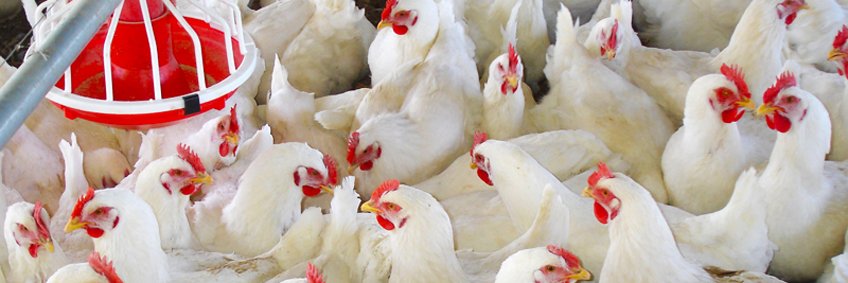Broiler Management

Broiler
It is a bird of about 8 weeks of age of either sex (straight-run chicks) with an average body weight of 1.5 to 2.0 kg with a flexible breast bone cartilage, pliable and tender meat.
Housing systems
Broilers can be housed on deep-litter, slatted or wire floor or cages. However, cage, slat and wire floor rearing of broilers are not as popular as litter floor rearing, due to problems like breast blisters, leg weakness and higher initial investment.
Rearing systems
The systems of rearing refer to either single batch at a time (all-in all-out system) or multiple batches of brooding and rearing of broilers.
All-in all-out system
Under all-in all-out system, the farm will have only one batch of broilers, belonging to the same hatch at any time. Sufficient chicks will be purchased to accommodate the entire farm capacity, reared and marketed in a single lot.
This system is more hygienic, lesser sub-clinical infections and horizontal spreading of diseases and thereby lesser mortality rate, better growth rate and improved feed efficiency. However, this system is not suitable for large scale farming and needs higher fixed and working capital per bird.
Multiple batch system
The multiple batch system consists of rearing of more than one batch of chicks at any time, with a batch interval of 1 to 4 weeks. Here, the farmer is buying day-old chicks and selling grown up broilers at weekly, fortnightly, once in three weeks or at monthly intervals. The chicks are reared for five to six weeks of age, or until they attain the desired body weight and sold for table.
The ideal system for India at present is having 5 to 6 batches of broilers at any time, with weekly interval between batches and “direct retail marketing”. Here, the birds will be marketed daily, from 40 to 54 days of age, based on their body weight, i.e. heavier birds will be sold earlier; giving a chance for weaker birds to have a compensatory growth.
Floor space, feeder space and waterer space
The floor space requirement of broilers varies depending on their body weight at the time of marketing, housing systems, marketing age and ambient temperature. The feeder and waterer space also varies depending on the environmental temperature and health condition of the birds. The following is the approximate floor, feeder and waterer space requirement for broilers.
It is a bird of about 8 weeks of age of either sex (straight-run chicks) with an average body weight of 1.5 to 2.0 kg with a flexible breast bone cartilage, pliable and tender meat.
Housing systems
Broilers can be housed on deep-litter, slatted or wire floor or cages. However, cage, slat and wire floor rearing of broilers are not as popular as litter floor rearing, due to problems like breast blisters, leg weakness and higher initial investment.
Rearing systems
The systems of rearing refer to either single batch at a time (all-in all-out system) or multiple batches of brooding and rearing of broilers.
All-in all-out system
Under all-in all-out system, the farm will have only one batch of broilers, belonging to the same hatch at any time. Sufficient chicks will be purchased to accommodate the entire farm capacity, reared and marketed in a single lot.
This system is more hygienic, lesser sub-clinical infections and horizontal spreading of diseases and thereby lesser mortality rate, better growth rate and improved feed efficiency. However, this system is not suitable for large scale farming and needs higher fixed and working capital per bird.
Multiple batch system
The multiple batch system consists of rearing of more than one batch of chicks at any time, with a batch interval of 1 to 4 weeks. Here, the farmer is buying day-old chicks and selling grown up broilers at weekly, fortnightly, once in three weeks or at monthly intervals. The chicks are reared for five to six weeks of age, or until they attain the desired body weight and sold for table.
The ideal system for India at present is having 5 to 6 batches of broilers at any time, with weekly interval between batches and “direct retail marketing”. Here, the birds will be marketed daily, from 40 to 54 days of age, based on their body weight, i.e. heavier birds will be sold earlier; giving a chance for weaker birds to have a compensatory growth.
Floor space, feeder space and waterer space
The floor space requirement of broilers varies depending on their body weight at the time of marketing, housing systems, marketing age and ambient temperature. The feeder and waterer space also varies depending on the environmental temperature and health condition of the birds. The following is the approximate floor, feeder and waterer space requirement for broilers.
| Age | Floor space/ bird | Feeder space/ bird | Waterer space / bird |
| Up to 18 days | 450 cm2 (0.5 sq.ft.) |
3 cm | 1.5 cm |
| From 19 days to 42 days | 1000 cm2 (1.1 sq.ft.) | 6-7 cm | 3 cm |
Brooding and rearing of broilers
It is similar to that for egg-type chicks.
Cage rearing of broilers
Broilers can also be reared on cages. Broiler cages are similar to that of grower cages. To prevent the breast blisters, the bottom of the cage may be coated with some plastic materials. The floor space requirement in cages is 50% of the floor space needed in deep-litter. The relative advantages and disadvantages of cage rearing of broilers are,
Advantages
- Higher density of rearing possible
- Easy to catch the birds at market time and hence reduces bruising
- No expenditure on litter
- No incidences of coccidiosis
- Reduced cannibalism
- Cleaning and disinfection easier
- Better growth and feed efficiency
Disadvantages
- Higher incidences of breast-blisters which increases carcass condemnations
- Higher incidences of crooked keel
- Wing bones will be more brittle which will be a disadvantage for the processor also.
- Birds are not having access to the unidentified growth factors in deep-litter system.
- Cleaning faecal-trays is not labour friendly.
- High initial investment on cages.
- Birds will be uncomfortable especially during summer
Feeding
Generally, three types of feed are offered to broilers from day-old to marketing.
0-2 Weeks – Broiler Pre-starter mash / crumble
3-4 Weeks – Broiler Starter mash
5-6 Weeks – Broiler Finisher mash
Lighting
In open sided broiler houses, the most commonly recommended lighting programme is 24 hours light during brooding period, followed by 23 hours light and one hour darkness per day, until marketing. This one hour darkness is to train the birds to acclimatize for darkness, in case of power failure, which may cause panic and trampling.
Vaccination schedule
Generally, three types of feed are offered to broilers from day-old to marketing.
0-2 Weeks – Broiler Pre-starter mash / crumble
3-4 Weeks – Broiler Starter mash
5-6 Weeks – Broiler Finisher mash
Lighting
In open sided broiler houses, the most commonly recommended lighting programme is 24 hours light during brooding period, followed by 23 hours light and one hour darkness per day, until marketing. This one hour darkness is to train the birds to acclimatize for darkness, in case of power failure, which may cause panic and trampling.
Vaccination schedule
S.No. |
Age | Vaccine | Route of administration |
| 1 | First day | Marek’s (at hatchery) | S/C at neck |
| 2 | 5-7th day | RDV F1 | I/O or I/N |
| 3 | 14th day | IBD Vaccine | I/O or I/N |
| 4 | 21st day | RDV La Sota | Drinking water |
| 5 | 28th day | IBD Vaccine (Booster) | Drinking water |
Sex-separate rearing of broilers
The growth rate, floor space and the nutrient requirements of male and female broilers are not the same. Since the males grow faster than females, males need higher floor space and nutrients than female broilers. Due to these reasons, male and female broiler chicks are reared separately, in many countries, from day-old to disposal. Here, day-old broiler chicks are sexed by “feather sexing method” rather than by “vent-sexing”, as in the case of egg-type chicks. The sexed broiler chicks are brood and reared separately until marketing. Separate diets are provided for males and females. Male broilers require more protein, whereas the females require less energy and less protein.
Advantages
- More uniform body weight of flocks can be produced by separate rearing of sexes.
- Specialized market requirement can be met. The females can be reared, dressed and sold as whole chicken; whereas the male carcasses will be exclusively used for deboning and various cut-up parts.
- More accurate feeding to meet out the specific requirement of each sex will be possible. This will lead to better growth rate and feed efficiency.
- Due to flock uniformity, the automatic processing equipments can be adjusted more accurately for greater processing efficiency and minimum condemnations.
- Minimise the incidence of cannibalism and peck order, due to more flock uniformity.
Disadvantages
- Increased costs of sexing.
- Larger breeding flocks are necessary to meet the demand for male and female broiler chicks. In turn, hatcheries may require that their customers always purchase equal number of male and female chicks.
Source: - http://agritech.tnau.ac.in









.jpg)



